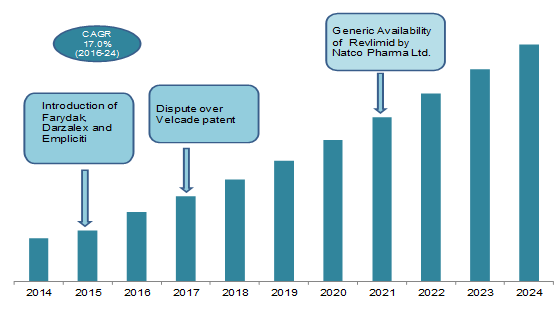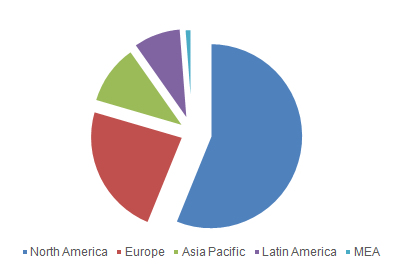- Home
- »
- Pharmaceuticals
- »
-
Multiple Myeloma Therapeutics Market Size Report, 2024GVR Report cover
![Multiple Myeloma Therapeutics Market Report]()
Multiple Myeloma Therapeutics Market Analysis, By Therapy Type (Chemotherapy And Other Drugs, Radiation, Stem Cell Transplant, Other Supportive Treatments), And Segment Forecasts, 2018 - 2024
- Report ID: GVR-4-68039-913-1
- Number of Report Pages: 80
- Format: PDF, Horizon Databook
- Historical Range: 2014 - 2015
- Forecast Period: 2016 - 2024
- Industry: Healthcare
Report Overview
The global multiple myeloma therapeutics market size was valued at USD 7.5 billion in 2015 and is projected to grow at a CAGR of 16.6% over the forecast period. The high growth is anticipated on account of the approval attained for the newer drugs in the market. In addition, the limited efficiency of the available drugs and the growing prevalence of the condition along with the increasing geriatric population are the factors expected to provide a huge platform for new drug development.
Multiple myeloma has been the third-most prevalent blood cancer across the world in the last decade. Advanced diagnostic techniques such as imaging devices and personalized diagnostic tests are available to facilitate the diagnostic process. However, the complexity, inefficiency, and high costs of the currently available therapeutic options demand advanced methods, which would significantly increase the lifespan of multiple myeloma patients.
Multiple Myeloma Therapeutics Market, USD Million, 2014 - 2024

The majority of multiple myeloma patients belong to the age group of 60-70 years. The geriatric population pool is expanding with increasing life expectancy. Variations in response of the aged people to medication make it difficult for oncologists to determine the appropriate dose regimen. Additionally, procedures such as stem cell transplants cannot be performed on physically weak patients. This scenario requires the development of targeted drugs, such as immunomodulation agents and monoclonal antibodies,which have a lesser deteriorating impact on patient health.
Therapy Type Insights
Chemotherapy and other drugs segment dominated the segment with the largest revenue share. Unavailability of alternatives and limitations of surgical procedures are the factors driving the focus of oncologists toward chemotherapy for treating multiple myeloma. Several pipeline drugs undergoing phase III clinical trials with positive clinical outcomes are expected to engender a surge in the industry growth upon the launch of these novel drugs during the forecast period.
Stem cell transplant and radiation therapies include the first-line therapy for multiple myeloma. However, the associated demerits including complications in stem cell transplant procedures and limited applications of radiation methods are driving the oncologists preference for multi-therapy regimens, which include a combination of chemotherapy, radiation, and other supportive treatments based on patient response and symptoms.
Immunomodulation agents dominated the chemotherapy and other drugs segment, while the monoclonal antibodies segment is expected to grow at the fastest CAGR. The chemotherapy and other drugs segment include traditional chemotherapy, immunomodulating agents, proteasome inhibitors, Histone deacetylase (HDAC) inhibitors, and monoclonal antibodies. Immunomodulating agents currently dominated the segment by capturing the majority of the industry share.
Adoption of Celgene’s Revlimid (Lenalidomide) and Pomalyst (Pomalidomide) immunomodulating drugs with high efficiency is expected to drive the sector growth during the forecast period. Recent introduction of monoclonal antibodies, such as Empliciti by Bristol-Myers Squibb and Darzalex by Janssen Biotech, Inc., are expected to render the fastest growth to the segment.
Regional Insights
North America is dominating the global multiple myeloma therapeutics market. The presence of large companies and the high adoption rate for newer treatment options are the factors contributing to the dominance of the region. Due to the large patient base and growing adoption of novel therapeutic approaches in the region, the Asia Pacific is expected to witness the fastest growth during the forecast period.
Global Multiple Myeloma Therapeutics Market, by Region, 2015

Additionally, growing efforts by the government and non-government organizations to increase patient cognizance of the newer treatment options are exerting a positive impact in supporting the emergence of this vertical.
Competitive Insights
Multiple myeloma therapeutics is a consolidated market. Celgene Corporation accounts for a large company share with its high revenue-generating drugs, Revlimid and Pomalyst. Other major players include Janssen Biotech, Inc., Bristol-Myers Squibb Company, Novartis AG, Millennium Pharmaceuticals, Amgen, Inc., Genzyme Corporation, and Juno Therapeutics. Most of the companies are focusing on developing combination drug therapies along with the development of new drugs.
Recent Developments
-
In February 2022, Janssen Pharmaceutical announced the U.S. FDA approval of CARVYKTI™ for the treatment of adults with relapsed or refractory multiple myeloma (RRMM). CARVYKTI™ therapy features two B-cell maturation antigens (BCMA)-targeting single-domain antibodies.
-
In February 2022, Sandoz, a division of Novartis launched generic lenalidomide for patients in 19 countries. The product launch aimed to reduce the high cost of multiple myeloma treatment.
-
In December 2021, Amgen announced the approval from FDA for a new combination regimen of KYPROLIS® (carfilzomib), DARZALEX FASPRO® (daratumumab and hyaluronidase-fihj), and dexamethasone for patients suffering from relapsed or refractory multiple myeloma.
-
In May 2021, Bristol Myers Squibb Canada (BMS) announced approval from Health Canada for ABECMATM for patients with multiple myeloma (MM).
Report Scope
Attribute
Details
Base year for estimation
2015
Actual estimates/Historic data
2014 - 2015
Forecast period
2016 - 2024
Market representation
Revenue in USD Million & CAGR from 2016 to 2024
Regional scope
North America, Europe, Asia Pacific, Latin America & MEA
Country scope
U.S., Canada, UK, Germany, Japan, India, Brazil, Mexico, and South Africa.
Report coverage
Revenue, company share, competitive landscape, growth factors, trends
15% free customization scope: Equivalent to 5 analyst working days
If you need specific market information, which is not currently within the scope of the report, we will provide it to you as a part of customization.
Segments Covered in the Report
This report forecasts revenue growth and provides an analysis on the industry trends in each of the sub-segments from 2014 to 2025. For the purpose of this study, Grand View Research has segmented the multiple myeloma therapeutics market on the basis of type and region:
- Type Outlook (Revenue, USD Billion, 2014 - 2024)
-
Chemotherapy and other drugs
-
Traditional chemotherapy
-
Immunomodulating agents
-
Proteasome inhibitors
-
Histone Deacetylase (HDAC) inhibitors
-
Monoclonal Antibodies
-
-
Radiation
-
Stem cell transplant and supportive treatment
-
- Regional Outlook (Revenue, USD Billion, 2014 - 2024)
-
North America
-
U.S.
-
Canada
-
-
Europe
-
UK
-
Germany
-
-
Asia Pacific
-
Japan
-
India
-
-
Latin America
-
Brazil
-
Mexico
-
-
Middle East and Africa
-
South Africa
-
-
Share this report with your colleague or friend.
![gvr icn]()
NEED A CUSTOM REPORT?
We can customize every report - free of charge - including purchasing stand-alone sections or country-level reports, as well as offer affordable discounts for start-ups & universities. Contact us now
![Certified Icon]()
We are GDPR and CCPA compliant! Your transaction & personal information is safe and secure. For more details, please read our privacy policy.
We are committed towards customer satisfaction, and quality service.
"The quality of research they have done for us has been excellent."





